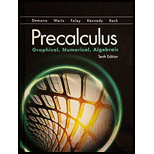
Concept explainers
(a)
To find: The linear regression model and scatter graph.
The model of the given data
Given information
The table for the given data is below.
| period | 1 | 6 | 11 | 16 | 21 | 26 | 31 | 36 | 41 |
| temperature | 2600 | 2390 | 3310 | 3720 | 4560 | 5110 | 6860 | 8820 | 9650 |
The equation is
The values are calculated using the following table
| x | y | x2 | x3 | x4 | x·y | x2·y |
| 1 | 2600 | 1 | 1 | 1 | 2600 | 2600 |
| 6 | 2390 | 36 | 216 | 1296 | 14340 | 86040 |
| 11 | 3310 | 121 | 1331 | 14641 | 36410 | 400510 |
| 16 | 3720 | 256 | 4096 | 65536 | 59520 | 952320 |
| 21 | 4560 | 441 | 9261 | 194481 | 95760 | 2010960 |
| 26 | 5110 | 676 | 17576 | 456976 | 132860 | 3454360 |
| 31 | 6860 | 961 | 29791 | 923521 | 212660 | 6592460 |
| 36 | 8820 | 1296 | 46656 | 1679616 | 317520 | 11430720 |
| 41 | 9650 | 1681 | 68921 | 2825761 | 395650 | 16221650 |
| --- | --- | --- | --- | --- | --- | --- |
| ∑x=189 | ∑y=47020 | ∑x·y=1267320 |
Substituting these values in the normal equations
9a+189b+5469c=47020
189a+5469b+177849c=1267320
5469a+177849b+6161829c=41151620
Solving these 3 equations,
Total Equations are 3
9a+189b+5469c=47020→(1)
189a+5469b+177849c=1267320→(2)
5469a+177849b+6161829c=41151620→(3)
Select the equations (1) and (2), and eliminate the variable a.

Select the equations (1) and (3), and eliminate the variable a.

Select the equations (4) and (5), and eliminate the variable b.

Now use back substitution method
From (6)
577500c=2470000
⇒c=2470000577500=4.2771
From (4)
-1500b-63000c=-279900
⇒-1500b-63000(4.2771)=-279900
⇒-1500b-269454.5455=-279900
⇒-1500b=-279900+269454.5455=-10445.4545
⇒b=-10445.4545-1500=6.9636
From (1)
9a+189b+5469c=47020
⇒9a+189(6.9636)+5469(4.2771)=47020
⇒9a+24707.3481=47020
⇒9a=47020-24707.3481=22312.6519
⇒a=22312.65199=2479.1835
Solution using Elimination method.
a=2479.1835,b=6.9636,c=4.2771
Now substituting this values in the equation is
Scatter graph of the following data given below
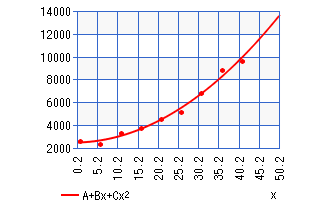
(b)
To find: The quadratic regression model and scatter graph.
The model of the given data
Given information
The table for the given data is below.
| period | 1 | 6 | 11 | 16 | 21 | 26 | 31 | 36 | 41 |
| temperature | 2600 | 2390 | 3310 | 3720 | 4560 | 5110 | 6860 | 8820 | 9650 |
The equation is
The values are calculated using the following table
| x | y | x2 | x3 | x4 | x5 | x6 | x·y | x2·y | x3·y |
| 1 | 2600 | 1 | 1 | 1 | 1 | 1 | 2600 | 2600 | 2600 |
| 6 | 2390 | 36 | 216 | 1296 | 7776 | 46656 | 14340 | 86040 | 516240 |
| 11 | 3310 | 121 | 1331 | 14641 | 161051 | 1771561 | 36410 | 400510 | 4405610 |
| 16 | 3720 | 256 | 4096 | 65536 | 1048576 | 16777216 | 59520 | 952320 | 15237120 |
| 21 | 4560 | 441 | 9261 | 194481 | 4084101 | 85766121 | 95760 | 2010960 | 42230160 |
| 26 | 5110 | 676 | 17576 | 456976 | 11881376 | 308915776 | 132860 | 3454360 | 89813360 |
| 31 | 6860 | 961 | 29791 | 923521 | 28629151 | 887503681 | 212660 | 6592460 | 204366260 |
| 36 | 8820 | 1296 | 46656 | 1679616 | 60466176 | 2176782336 | 317520 | 11430720 | 411505920 |
| 41 | 9650 | 1681 | 68921 | 2825761 | 115856201 | 4750104241 | 395650 | 16221650 | 665087650 |
| --- | --- | --- | --- | --- | --- | --- | --- | --- | --- |
| ∑x=189 | ∑y=47020 | ∑x2=5469 | ∑x3=177849 | ∑x4=6161829 | ∑x5=222134409 | ∑x6=8227667589 | ∑x·y=1267320 | ∑x2·y=41151620 | ∑x3·y=1433164920 |
Substituting these values in the normal equations
9a+189b+5469c+177849d=47020
189a+5469b+177849c+6161829d=1267320
5469a+177849b+6161829c+222134409d=41151620
177849a+6161829b+222134409c+8227667589d=1433164920
Solving these 4 equations,
Total Equations are 4
9a+189b+5469c+177849d=47020→(1)
189a+5469b+177849c+6161829d=1267320→(2)
5469a+177849b+6161829c+222134409d=41151620→(3)
177849a+6161829b+222134409c+8227667589d=1433164920→(4)
Select the equations (1) and (2), and eliminate the variable a.

Select the equations (1) and (3), and eliminate the variable a.
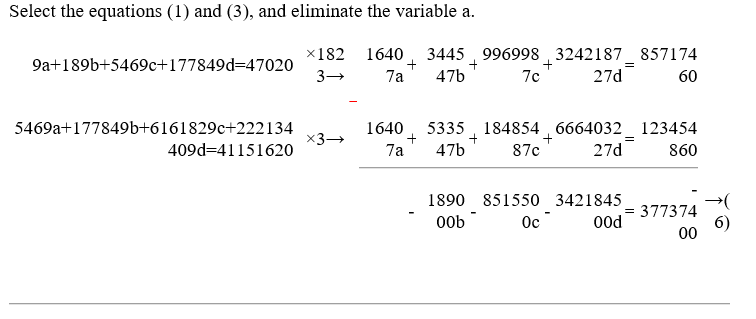
Select the equations (1) and (4), and eliminate the variable a.
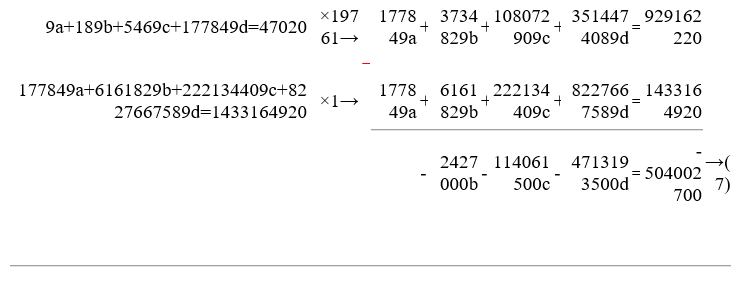
Select the equations (5) and (6), and eliminate the variable b.

Select the equations (5) and (7), and eliminate the variable b.
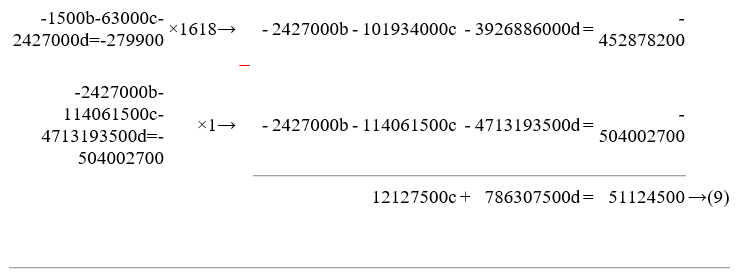
Select the equations (8) and (9), and eliminate the variable c.

Now use back substitution method
From (10)
-22275000d=745500
⇒d=745500-22275000=-0.0335
From (8)
577500c+36382500d=2470000
⇒577500c+36382500(-0.0335)=2470000
⇒577500c-1217650=2470000
⇒577500c=2470000+1217650=3687650
⇒c=3687650577500=6.3855
From (5)
-1500b-63000c-2427000d=-279900
⇒-1500b-63000(6.3855)-2427000(-0.0335)=-279900
⇒-1500b-321062.2222=-279900
⇒-1500b=-279900+321062.2222=41162.2222
⇒b=41162.2222-1500=-27.4415
From (1)
9a+189b+5469c+177849d=47020
⇒9a+189(-27.4415)+5469(6.3855)+177849(-0.0335)=47020
⇒9a+23783.8317=47020
⇒9a=47020-23783.8317=23236.1683
⇒a=23236.16839=2581.7965
Solution using Elimination method.
a=2581.7965,b=-27.4415,c=6.3855,d=-0.0335
Now substituting this values in the equation is
Scatter graph of the model is given below.
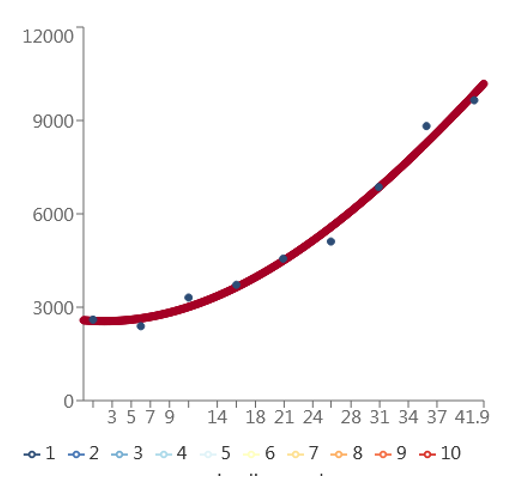
(c)
To find: The cost of tuition fee in 2021.
According to quadratic regression the cost of tuition fee in 2021 is 11849 .
According to cubic regression the cost of tuition fee in 2021 is 14082
Given informationquadratic regression is
Substitute x=46 in the above equation
Cubic equation model is
Now Substitute x=46 in the above equation
(d)
To find: The end behaviour of the model.
The model of the given data
Given information
According to quadratic model the future expense will not go too high. But the cubic model says otherwise. It predicts that future expanse will be very high.
Chapter 2 Solutions
EBK PRECALCULUS:GRAPHICAL,...-NASTA ED.
- 3. Determine the appropriate annihilator for the given F(x). a) F(x) = 5 cos 2x b) F(x)=9x2e3xarrow_forwardTangent planes Find an equation of the plane tangent to the following surfaces at the given points (two planes and two equations).arrow_forwardVectors u and v are shown on the graph.Part A: Write u and v in component form. Show your work. Part B: Find u + v. Show your work.Part C: Find 5u − 2v. Show your work.arrow_forward
- Vectors u = 6(cos 60°i + sin60°j), v = 4(cos 315°i + sin315°j), and w = −12(cos 330°i + sin330°j) are given. Use exact values when evaluating sine and cosine.Part A: Convert the vectors to component form and find −7(u • v). Show every step of your work.Part B: Convert the vectors to component form and use the dot product to determine if u and w are parallel, orthogonal, or neither. Justify your answer.arrow_forwardSuppose that one factory inputs its goods from two different plants, A and B, with different costs, 3 and 7 each respective. And suppose the price function in the market is decided as p(x, y) = 100 - x - y where x and y are the demand functions and 0 < x, y. Then as x = y= the factory can attain the maximum profit,arrow_forwardf(x) = = x - 3 x²-9 f(x) = {x + 1 x > 3 4 x < 3 -10 5 10 5 5. 10 5- 07. 10 -10 -5 0 10 5 -101 :: The function has a “step" or "jump" discontinuity at x = 3 where f(3) = 7. :: The function has a value of f (3), a limit as x approaches 3, but is not continuous at x = 3. :: The function has a limit as x approaches 3, but the function is not defined and is not continuous at x = 3. :: The function has a removable discontinuity at x=3 and an infinite discontinuity at x= -3.arrow_forward
- Calculus lll May I please have the solutions for the following examples? Thank youarrow_forwardCalculus lll May I please have the solutions for the following exercises that are blank? Thank youarrow_forwardThe graph of 2(x² + y²)² = 25 (x²-y²), shown in the figure, is a lemniscate of Bernoulli. Find the equation of the tangent line at the point (3,1). -10 Write the expression for the slope in terms of x and y. slope = 4x³ + 4xy2-25x 2 3 4x²y + 4y³ + 25y Write the equation for the line tangent to the point (3,1). LV Q +arrow_forward
- Find the equation of the tangent line at the given value of x on the curve. 2y3+xy-y= 250x4; x=1 y=arrow_forwardFind the equation of the tangent line at the given point on the curve. 3y² -√x=44, (16,4) y=] ...arrow_forwardFor a certain product, cost C and revenue R are given as follows, where x is the number of units sold in hundreds. Cost: C² = x² +92√x+56 Revenue: 898(x-6)² + 24R² = 16,224 dC a. Find the marginal cost at x = 6. dx The marginal cost is estimated to be $ ☐ . (Do not round until the final answer. Then round to the nearest hundredth as needed.)arrow_forward
 Calculus: Early TranscendentalsCalculusISBN:9781285741550Author:James StewartPublisher:Cengage Learning
Calculus: Early TranscendentalsCalculusISBN:9781285741550Author:James StewartPublisher:Cengage Learning Thomas' Calculus (14th Edition)CalculusISBN:9780134438986Author:Joel R. Hass, Christopher E. Heil, Maurice D. WeirPublisher:PEARSON
Thomas' Calculus (14th Edition)CalculusISBN:9780134438986Author:Joel R. Hass, Christopher E. Heil, Maurice D. WeirPublisher:PEARSON Calculus: Early Transcendentals (3rd Edition)CalculusISBN:9780134763644Author:William L. Briggs, Lyle Cochran, Bernard Gillett, Eric SchulzPublisher:PEARSON
Calculus: Early Transcendentals (3rd Edition)CalculusISBN:9780134763644Author:William L. Briggs, Lyle Cochran, Bernard Gillett, Eric SchulzPublisher:PEARSON Calculus: Early TranscendentalsCalculusISBN:9781319050740Author:Jon Rogawski, Colin Adams, Robert FranzosaPublisher:W. H. Freeman
Calculus: Early TranscendentalsCalculusISBN:9781319050740Author:Jon Rogawski, Colin Adams, Robert FranzosaPublisher:W. H. Freeman
 Calculus: Early Transcendental FunctionsCalculusISBN:9781337552516Author:Ron Larson, Bruce H. EdwardsPublisher:Cengage Learning
Calculus: Early Transcendental FunctionsCalculusISBN:9781337552516Author:Ron Larson, Bruce H. EdwardsPublisher:Cengage Learning





